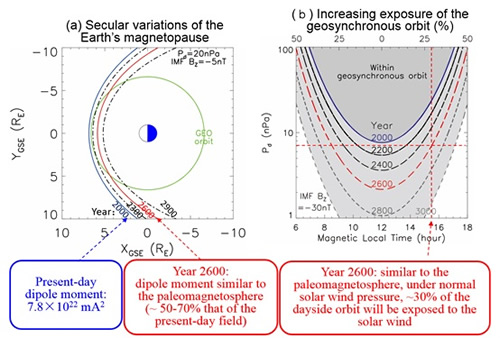Shrinkage of the Earth’s magnetosphere due to decay of its dipole fieldUpdate time:04 13, 2015
The Earth’s magnetosphere is formed by the interaction of the solar wind with Earth’s dipole magnetic field. The boundary between the solar wind and Earth’s magnetic field is called the magnetopause. This boundary separates the magnetospheric plasma from the solar wind and determines the size of the magnetosphere (Figure 1). It plays a crucial role in protecting Earth from the harmful effects of the solar wind. To predict the magnetopause location, various empirical models have been developed over the Zhong et al. developed a magnetopause location model that is parameterized by both the Earth’s dipole moment and the solar wind conditions, and investigated the influence of the decreasing dipole moment on the average magnetopause location. The results show that, if the declining dipole trend continues, the average subsolar magnetopause distance would move earthward by 2000 km per century (Figure 2a). They also quantitatively evaluated the increasing exposure of geosynchronous orbit in the solar wind caused by the decay of dipole moment and the variation of solar wind conditions, and studied the possible situation
Figure 1. Earth magnetosphere: basic dipolar magnetosphere with distance to subsolar magnetopause (RMP).
Figure 2. (a) The secular variations of the magnetopause location from the model; (b) the increasing exposure of This study has published in January 2015 in the Journal of Geophysical Research:Space Physics(Zhong, J. et al. Increasing exposure of geosynchronous orbit in solar wind due to decay of Earth's dipole field, Journal of Geophysical Research: Space Physics, 2014, 119: 9816–9822)(Link)
|
Contact
Related Articles
Reference
|
-
SIMSSecondary Ion Mass Spectrometer Laboratory
-
MC-ICPMSMultiple-collector ICPMS Laboratory
-
EM & TEMElectron Microprobe and Transmission Electron Microscope Laboratory
-
SISolid Isotope Laboratory
-
StIStable Isotope Laboratory
-
RMPARock-Mineral Preparation and Analysis
-
AAH40Ar/39Ar & (U-Th)/He Laboratory
-
EMLElectron Microscopy Laboratory
-
USCLUranium Series Chronology Laboratory
-
SASeismic Array Laboratory
-
SEELaboratory of Space Environment Exploration Laboratory
-
PGPaleomagnetism and Geochronology Laboratory
-
BioMNSFrance-China Bio-mineralization and Nano-structure Laboratory

 Print
Print Close
Close


